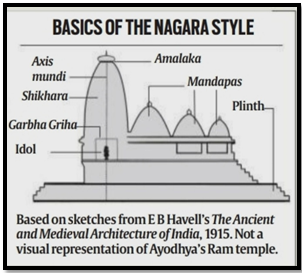RAM TEMPLE ARCHITECTURE IN NAGARA STYLE
Focus:
- Designed by Chandrakant Sompura and his son Ashish, the Ram temple in Ayodhya follows the Nagarastyle of architecture.
Source: IE
About Nagara Style of Architecture:
- Nagarastyle emerged in the fifth century CE in Northern India, contrasting with the Dravida style of Southern India.
- Nagar temples feature a raised plinth, with the garbhagriha as the most sacred part.
- The towering shikhara, resembling a mountain peak, is a distinctive aspect of Nagar style.
- Additional components include a circumambulatory passage around the garbhagriha and one or more mandapas (halls).
Five Modes of Nagar Style:
- Nagar temple architecture exhibits five modes: Valabhi, Phamsana, Latina, Shekhari, and Bhumija.
- Each mode represents variations in shikhara design based on period and geography.
- The Latina mode, a slightly curved tower, dominated Nagar temple architecture for three centuries.
| Comparison to Dravida Style
· Contrary to the Dravida style’s vimana, Nagar temples feature shikharas as the towering structures. · Unlike Nagar temples, Dravida style incorporates gopurams, striking gatehouses that dominate the temple complex. · Unique to Ayodhya’s Ram temple is a 732-meter-long wall surrounding the compound, resembling a hybrid feature. |

 Source: IE
Source: IE


